Tectonic–Climate Interactions Controlled the Episodic Magmatism and Exhumation of the Zheduo–Gongga Massif in the Eastern Tibetan Plateau
Abstract
:1. Introduction
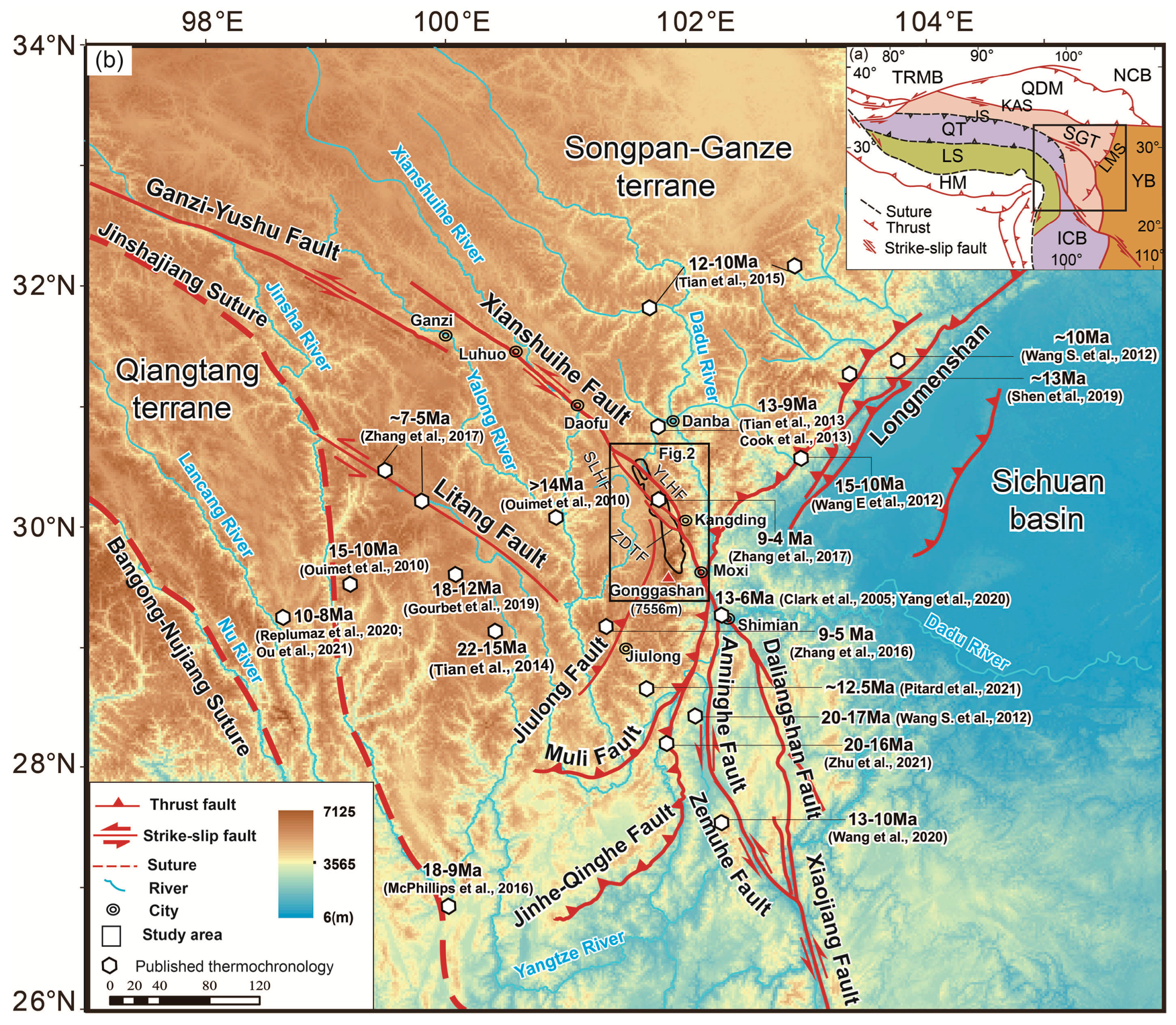
2. Geological Setting
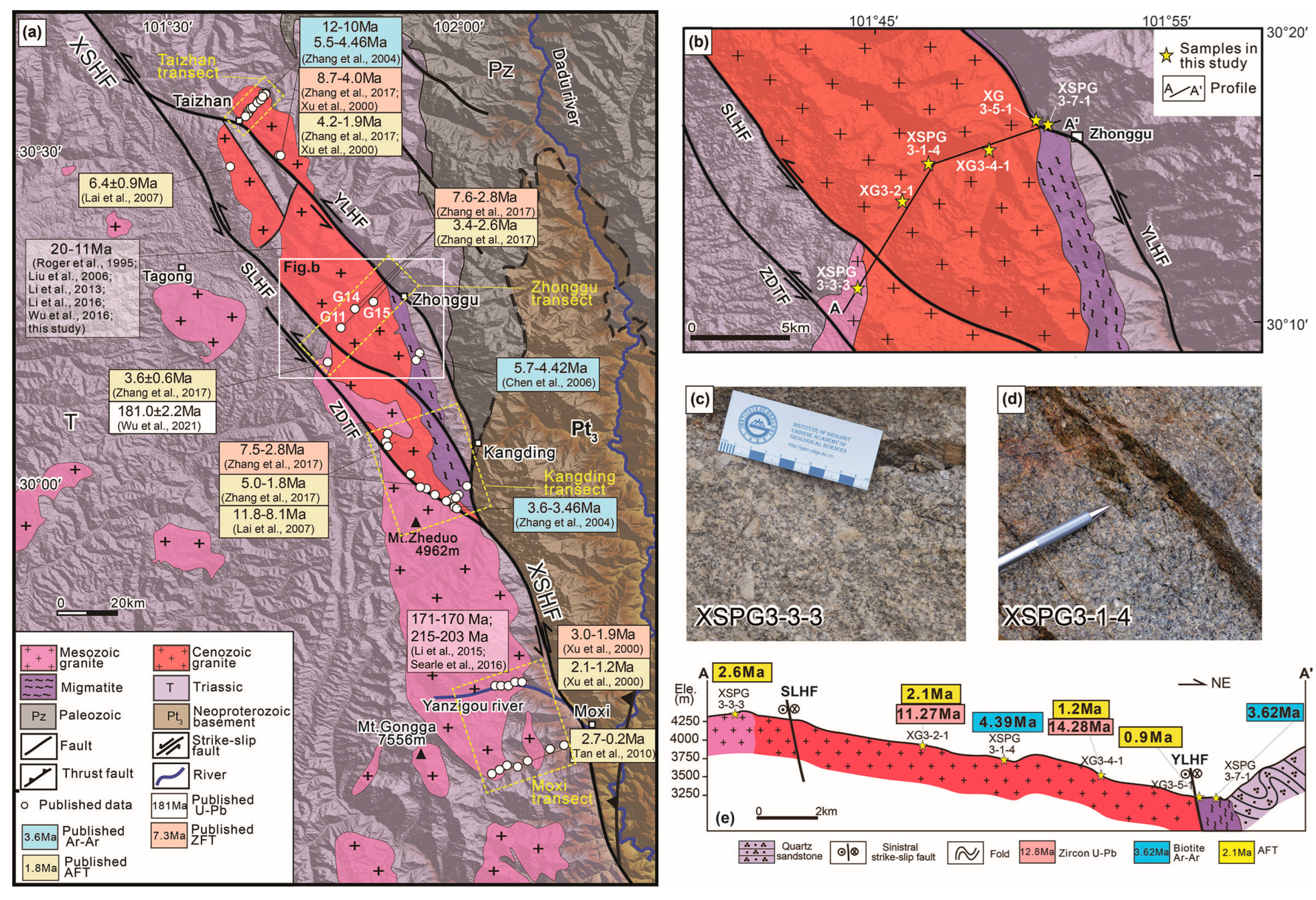
3. Sampling and Methods
3.1. Sampling
3.2. Zircon U-Pb Dating
3.3. Biotite 40Ar–39Ar Dating
3.4. AFT Dating
3.5. Thermal Modeling
4. Results and Interpretation
4.1. LA–ICP–MS Zircon U–Pb Age
4.2. 40Ar–39Ar Results
4.3. AFT Dating Results
4.4. Thermal History Modeling Results
5. Discussion
5.1. Late Cenozoic Cooling and Exhumation of the Zheduo–Gongga Massif
5.2. Magmatic Cooling or Rock Exhumation
5.3. Activity of the Xianshuihe Fault
5.4. Dynamics of the Zheduo–Gongga Mountain Building and Exhumation
6. Conclusions
Supplementary Materials
Author Contributions
Funding
Data Availability Statement
Acknowledgments
Conflicts of Interest
References
- Royden, L.H.; Burchfiel, B.C.; King, R.W.; Wang, E.; Chen, Z.; Shen, F.; Liu, Y. Surface deformation and lower crustal flow in eastern Tibet. Science 1997, 276, 788–790. [Google Scholar] [CrossRef] [PubMed]
- Royden, L.H.; Burchfiel, B.C.; van der Hilst, R.D. The geological evolution of the Tibetan Plateau. Science 2008, 321, 1054–1058. [Google Scholar] [CrossRef] [PubMed]
- Clark, M.K.; Royden, L.H. Topographic ooze: Building the eastern margin of Tibet by lower crustal flow. Geology 2000, 28, 703–706. [Google Scholar] [CrossRef]
- Clark, M.K.; House, M.; Royden, L.; Whipple, K.; Burchfiel, B.; Zhang, X.; Tang, W. Late Cenozoic uplift of southeastern Tibet. Geology 2005, 33, 525–528. [Google Scholar] [CrossRef]
- Bai, D.; Unsworth, M.J.; Meju, M.A.; Ma, X.; Teng, J.; Kong, X.; Sun, Y.; Sun, J.; Wang, L.; Jiang, C. Crustal deformation of the eastern Tibetan plateau revealed by magnetotelluric imaging. Nat. Geosci. 2010, 3, 358–362. [Google Scholar] [CrossRef]
- Ji, L.; Liu, F.; Palin, R.; Wang, F.; Sun, Z. Thermal and physical properties of Barrovian metamorphic sequence rocks in the Ailao Shan-Red River shear zone, and implications for crustal channel flow. J. Geophys. Res. Solid Earth 2024, 129, e2023JB027253. [Google Scholar] [CrossRef]
- Zhao, P.; Chen, J.; Li, Y.; Liu, Q.; Chen, Y.; Guo, B.; Yin, X. Growth of the northeastern Tibetan plateau driven by crustal channel flow: Evidence from high-resolution ambient noise imaging. Geophys. Res. Lett. 2021, 48, e2021GL093387. [Google Scholar] [CrossRef]
- Zhang, G.; Tian, Y.; Li, R.; Shen, X.; Zhang, Z.; Sun, X.; Chen, D. Progressive tectonic evolution from crustal shortening to mid-lower crustal expansion in the southeast Tibetan Plateau: A synthesis of structural and thermochronological insights. Earth-Sci. Rev. 2022, 226, 103951. [Google Scholar] [CrossRef]
- Zhang, Z.; Nie, J.; Saylor, J.; Gao, S.; Xiao, W. Shortening and asthenospheric flow drove Miocene vertical-axis rotations in the northern Tibetan Plateau: A palaeomagnetic study of the northeast Qaidam Basin of China. Palaeogeogr. Palaeoclimatol. Palaeoecol. 2024, 647, 112263. [Google Scholar] [CrossRef]
- Tapponnier, P.; Zhiqin, X.; Roger, F.; Meyer, B.; Arnaud, N.; Wittlinger, G.; Jingsui, Y. Oblique stepwise rise and growth of the Tibet Plateau. Science 2001, 294, 1671–1677. [Google Scholar] [CrossRef]
- Yin, A. Cenozoic tectonic evolution of Asia: A preliminary synthesis. Tectonophysics 2010, 488, 293–325. [Google Scholar] [CrossRef]
- Tian, Y.; Kohn, B.P.; Hu, S.; Gleadow, A.J. Synchronous fluvial response to surface uplift in the eastern Tibetan Plateau: Implications for crustal dynamics. Geophys. Res. Lett. 2015, 42, 29–35. [Google Scholar] [CrossRef]
- Liu-Zeng, J.; Zhang, J.; McPhillips, D.; Reiners, P.; Wang, W.; Pik, R.; Zeng, L.; Hoke, G.; Xie, K.; Xiao, P. Multiple episodes of fast exhumation since Cretaceous in southeast Tibet, revealed by low-temperature thermochronology. Earth Planet. Sci. Lett. 2018, 490, 62–76. [Google Scholar] [CrossRef]
- Cao, K.; Wang, G.; Leloup, P.H.; Mahéo, G.; Xu, Y.; van Der Beek, P.A.; Replumaz, A.; Zhang, K. Oligocene-Early Miocene topographic relief generation of southeastern Tibet triggered by thrusting. Tectonics 2019, 38, 374–391. [Google Scholar] [CrossRef]
- Beaumont, C.; Jamieson, R.A.; Nguyen, M.; Lee, B. Himalayan tectonics explained by extrusion of a low-viscosity crustal channel coupled to focused surface denudation. Nature 2001, 414, 738–742. [Google Scholar] [CrossRef]
- Whipple, K.X. The influence of climate on the tectonic evolution of mountain belts. Nat. Geosci. 2009, 2, 97–104. [Google Scholar] [CrossRef]
- Li, M.; Seybold, H.; Wu, B.; Chen, Y.; Kirchner, J.W. Interaction between tectonics and climate encoded in the planform geometry of stream networks on the eastern Tibetan Plateau. Geophys. Res. Lett. 2023, 50, e2023GL104121. [Google Scholar] [CrossRef]
- Liu, F.; Danišík, M.; Zheng, D.; Gallagher, K.; Nie, J. Distinguishing tectonic versus climatic forcing on landscape evolution: An example from SE Tibetan Plateau. GSA Bull. 2021, 133, 233–242. [Google Scholar] [CrossRef]
- Lee, C.-T.A.; Thurner, S.; Paterson, S.; Cao, W. The rise and fall of continental arcs: Interplays between magmatism, uplift, weathering, and climate. Earth Planet. Sci. Lett. 2015, 425, 105–119. [Google Scholar] [CrossRef]
- Tada, R.; Zheng, H.; Clift, P.D. Evolution and variability of the Asian monsoon and its potential linkage with uplift of the Himalaya and Tibetan Plateau. Prog. Earth Planet. Sci. 2016, 3, 1–26. [Google Scholar] [CrossRef]
- Thiede, R.C.; Arrowsmith, J.R.; Bookhagen, B.; McWilliams, M.O.; Sobel, E.R.; Strecker, M.R. From tectonically to erosionally controlled development of the Himalayan orogen. Geology 2005, 33, 689–692. [Google Scholar] [CrossRef]
- Thiede, R.C.; Bookhagen, B.; Arrowsmith, J.R.; Sobel, E.R.; Strecker, M.R. Climatic control on rapid exhumation along the Southern Himalayan Front. Earth Planet. Sci. Lett. 2004, 222, 791–806. [Google Scholar] [CrossRef]
- Webb, A.A.G.; Guo, H.; Clift, P.D.; Husson, L.; Müller, T.; Costantino, D.; Yin, A.; Xu, Z.; Cao, H.; Wang, Q. The Himalaya in 3D: Slab dynamics controlled mountain building and monsoon intensification. Lithosphere 2017, 9, 637–651. [Google Scholar] [CrossRef]
- Schildgen, T.F.; van Der Beek, P.A.; Sinclair, H.D.; Thiede, R.C. Spatial correlation bias in late-Cenozoic erosion histories derived from thermochronology. Nature 2018, 559, 89–93. [Google Scholar] [CrossRef] [PubMed]
- Chen, W.; Zhang, Y.; Zhang, Y.; Jin, G.; Wang, Q. Late Cenozoic episodic uplifting in southeastern part of the Tibetan plateau-evidence from Ar-Ar thermochronology. Acta Petrol. Sin. 2006, 22, 867–872. [Google Scholar]
- Cook, K.; Royden, L.; Burchfiel, B.; Lee, Y.-H.; Tan, X. Constraints on Cenozoic tectonics in the southwestern Longmen Shan from low-temperature thermochronology. Lithosphere 2013, 5, 393–406. [Google Scholar] [CrossRef]
- Tan, X.-B.; Lee, Y.-H.; Xu, X.-W.; Cook, K.L. Cenozoic exhumation of the Danba antiform, eastern Tibet: Evidence from low-temperature thermochronology. Lithosphere 2017, 9, 534–544. [Google Scholar] [CrossRef]
- Tian, Y.; Kohn, B.P.; Gleadow, A.J.; Hu, S. Constructing the Longmen Shan eastern Tibetan Plateau margin: Insights from low-temperature thermochronology. Tectonics 2013, 32, 576–592. [Google Scholar] [CrossRef]
- Tian, Y.; Kohn, B.P.; Gleadow, A.J.; Hu, S. A thermochronological perspective on the morphotectonic evolution of the southeastern Tibetan Plateau. J. Geophys. Res. Solid Earth 2014, 119, 676–698. [Google Scholar] [CrossRef]
- Xu, G.; Kamp, P.J. Tectonics and denudation adjacent to the Xianshuihe Fault, eastern Tibetan Plateau: Constraints from fission track thermochronology. J. Geophys. Res. Solid Earth 2000, 105, 19231–19251. [Google Scholar] [CrossRef]
- Zhang, Y.; Chen, W.; Yang, N. 40Ar/39Ar dating of shear deformation of the Xianshuihe fault zone in west Sichuan and its tectonic significance. Sci. China Ser. D Earth Sci. 2004, 47, 794–803. [Google Scholar] [CrossRef]
- Yang, R.; Fellin, M.G.; Herman, F.; Willett, S.D.; Wang, W.; Maden, C. Spatial and temporal pattern of erosion in the Three Rivers Region, southeastern Tibet. Earth Planet. Sci. Lett. 2016, 433, 10–20. [Google Scholar] [CrossRef]
- Zhang, H.; Oskin, M.E.; Liu-Zeng, J.; Zhang, P.; Reiners, P.W.; Xiao, P. Pulsed exhumation of interior eastern Tibet: Implications for relief generation mechanisms and the origin of high-elevation planation surfaces. Earth Planet. Sci. Lett. 2016, 449, 176–185. [Google Scholar] [CrossRef]
- Zhang, Y.-Z.; Replumaz, A.; Leloup, P.H.; Wang, G.-C.; Bernet, M.; van der Beek, P.; Paquette, J.L.; Chevalier, M.-L. Cooling history of the Gongga batholith: Implications for the Xianshuihe Fault and Miocene kinematics of SE Tibet. Earth Planet. Sci. Lett. 2017, 465, 1–15. [Google Scholar] [CrossRef]
- Zhang, Y.Z.; Replumaz, A.; Wang, G.C.; Leloup, P.H.; Gautheron, C.; Bernet, M.; van der Beek, P.; Paquette, J.L.; Wang, A.; Zhang, K.X. Timing and rate of exhumation along the Litang fault system, implication for fault reorganization in Southeast Tibet. Tectonics 2015, 34, 1219–1243. [Google Scholar] [CrossRef]
- Cook, K.L.; Hovius, N.; Wittmann, H.; Heimsath, A.M.; Lee, Y.-H. Causes of rapid uplift and exceptional topography of Gongga Shan on the eastern margin of the Tibetan Plateau. Earth Planet. Sci. Lett. 2018, 481, 328–337. [Google Scholar] [CrossRef]
- Ouimet, W.; Whipple, K.; Royden, L.; Reiners, P.; Hodges, K.; Pringle, M. Regional incision of the eastern margin of the Tibetan Plateau. Lithosphere 2010, 2, 50–63. [Google Scholar] [CrossRef]
- Ouimet, W.B.; Whipple, K.X.; Granger, D.E. Beyond threshold hillslopes: Channel adjustment to base-level fall in tectonically active mountain ranges. Geology 2009, 37, 579–582. [Google Scholar] [CrossRef]
- Bai, M.; Chevalier, M.-L.; Pan, J.; Replumaz, A.; Leloup, P.H.; Métois, M.; Li, H. Southeastward increase of the late Quaternary slip-rate of the Xianshuihe fault, eastern Tibet. Geodynamic and seismic hazard implications. Earth Planet. Sci. Lett. 2018, 485, 19–31. [Google Scholar] [CrossRef]
- Yan, B.; Jia, D.; Lin, A. Late Pleistocene-Holocene tectonic landforms developed along the strike-slip Xianshuihe Fault Zone, Tibetan Plateau, China. J. Geodyn. 2018, 120, 11–22. [Google Scholar] [CrossRef]
- An, Z.; Kutzbach, J.E.; Prell, W.L.; Porter, S.C. Evolution of Asian monsoons and phased uplift of the Himalaya–Tibetan plateau since Late Miocene times. Nature 2001, 411, 62–66. [Google Scholar]
- Clift, P.D.; Webb, A.A.G. A history of the Asian monsoon and its interactions with solid Earth tectonics in Cenozoic South Asia. Geol. Soc. Lond. Spec. Publ. 2019, 483, 631–652. [Google Scholar] [CrossRef]
- Sun, J.; Ye, J.; Wu, W.; Ni, X.; Bi, S.; Zhang, Z.; Liu, W.; Meng, J. Late Oligocene–Miocene mid-latitude aridification and wind patterns in the Asian interior. Geology 2010, 38, 515–518. [Google Scholar] [CrossRef]
- Sun, X.; Wang, P. How old is the Asian monsoon system?—Palaeobotanical records from China. Palaeogeogr. Palaeoclimatol. Palaeoecol. 2005, 222, 181–222. [Google Scholar] [CrossRef]
- Liu, Q.Y.; Van Der Hilst, R.D.; Li, Y.; Yao, H.J.; Chen, J.H.; Guo, B.; Qi, S.H.; Wang, J.; Huang, H.; Li, S.C. Eastward expansion of the Tibetan Plateau by crustal flow and strain partitioning across faults. Nat. Geosci. 2014, 7, 361–365. [Google Scholar] [CrossRef]
- Tang, X.; Zhang, J.; Pang, Z.; Hu, S.; Tian, J.; Bao, S. The eastern Tibetan Plateau geothermal belt, western China: Geology, geophysics, genesis, and hydrothermal system. Tectonophysics 2017, 717, 433–448. [Google Scholar] [CrossRef]
- Shen, X.; Tian, Y.; Zhang, G.; Zhang, S.; Carter, A.; Kohn, B.; Vermeesch, P.; Liu, R.; Li, W. Late Miocene Hinterland Crustal Shortening in the Longmen Shan Thrust Belt, the Eastern Margin of the Tibetan Plateau. J. Geophys. Res. Solid Earth 2019, 124, 11972–11991. [Google Scholar] [CrossRef]
- Wang, E.; Kirby, E.; Furlong, K.P.; van Soest, M.; Xu, G.; Shi, X.; Kamp, P.J.J.; Hodges, K.V. Two-phase growth of high topography in eastern Tibet during the Cenozoic. Nat. Geosci. 2012, 5, 640–645. [Google Scholar] [CrossRef]
- Wang, S.; Jiang, G.; Xu, T.; Tian, Y.; Zheng, D.; Fang, X. The Jinhe–Qinghe fault—An inactive branch of the Xianshuihe–Xiaojiang fault zone, Eastern Tibet. Tectonophysics 2012, 544, 93–102. [Google Scholar]
- Yang, R.; Suhail, H.A.; Gourbet, L.; Willett, S.D.; Fellin, M.G.; Lin, X.; Gong, J.; Wei, X.; Maden, C.; Jiao, R. Early Pleistocene drainage pattern changes in Eastern Tibet: Constraints from provenance analysis, thermochronometry, and numerical modeling. Earth Planet. Sci. Lett. 2020, 531, 115955. [Google Scholar] [CrossRef]
- Pitard, P.; Replumaz, A.; Chevalier, M.L.; Leloup, P.H.; Bai, M.; Doin, M.P.; Thieulot, C.; Ou, X.; Balvay, M.; Li, H. Exhumation History Along the Muli Thrust—Implication for Crustal Thickening Mechanism in Eastern Tibet. Geophys. Res. Lett. 2021, 48, e2021GL093677. [Google Scholar] [CrossRef]
- Zhu, C.; Wang, G.; Leloup, P.H.; Cao, K.; Mahéo, G.; Chen, Y.; Zhang, P.; Shen, T.; Wu, G.; Sotiriou, P. Role of the early Miocene Jinhe-Qinghe Thrust Belt in the building of the Southeastern Tibetan Plateau topography. Tectonophysics 2021, 811, 228871. [Google Scholar] [CrossRef]
- Wang, H.; Li, K.; Tian, Y.; Zhang, G. Oligocene-Early Miocene exhumation and shortening along the Anninghe fault in the southeastern Tibetan Plateau: Insights from zircon and apatite (U-Th)/He thermochronology. Int. Geol. Rev. 2022, 64, 390–404. [Google Scholar] [CrossRef]
- Gourbet, L.; Yang, R.; Fellin, M.G.; Paquette, J.-L.; Willett, S.D.; Gong, J.; Maden, C. Evolution of the Yangtze River network, southeastern Tibet: Insights from thermochronology and sedimentology. Lithosphere 2020, 12, 3–18. [Google Scholar] [CrossRef]
- Replumaz, A.; San José, M.; Margirier, A.; van der Beek, P.; Gautheron, C.; Leloup, P.H.; Ou, X.; Cao, K.; Wang, G.c.; Zhang, Y.z. Tectonic control on rapid late Miocene—Quaternary incision of the Mekong River Knickzone, southeast Tibetan Plateau. Tectonics 2020, 39, e2019TC005782. [Google Scholar] [CrossRef]
- Ou, X.; Replumaz, A.; van der Beek, P. Contrasting exhumation histories and relief development within the Three Rivers Region (south-east Tibet). Solid Earth 2021, 12, 563–580. [Google Scholar] [CrossRef]
- McPhillips, D.; Hoke, G.D.; Liu-Zeng, J.; Bierman, P.R.; Rood, D.H.; Niedermann, S. Dating the incision of the Yangtze River gorge at the First Bend using three-nuclide burial ages. Geophys. Res. Lett. 2016, 43, 101–110. [Google Scholar] [CrossRef]
- Roger, F.; Calassou, S.; Lancelot, J.; Malavieille, J.; Mattauer, M.; Zhiqin, X.; Ziwen, H.; Liwei, H. Miocene emplacement and deformation of the Konga Shan granite (Xianshui He fault zone, west Sichuan, China): Geodynamic implications. Earth Planet. Sci. Lett. 1995, 130, 201–216. [Google Scholar] [CrossRef]
- Wang, S.; Fang, X.; Zheng, D.; Wang, E. Initiation of slip along the Xianshuihe fault zone, eastern Tibet, constrained by K/Ar and fission-track ages. Int. Geol. Rev. 2009, 51, 1121–1131. [Google Scholar] [CrossRef]
- Xu, Z.; Hou, L.; Wang, Z. The Orogeny of the Chinese Songpan-Ganze Orogen; Geological Publishing House: Beijing, China, 1992. (In Chinese) [Google Scholar]
- Wang, H.; Tian, Y.; Liang, M. Late Cenozoic exhumation history of the Luoji Shan in the southeastern Tibetan Plateau: Insights from apatite fission-track thermochronology. J. Geol. Soc. 2017, 174, 883–891. [Google Scholar] [CrossRef]
- Li, H.; Zhang, Y. Zircon U–Pb geochronology of the Konggar granitoid and migmatite: Constraints on the Oligo-Miocene tectono-thermal evolution of the Xianshuihe fault zone, East Tibet. Tectonophysics 2013, 606, 127–139. [Google Scholar] [CrossRef]
- Yan, B.; Lin, A. Systematic deflection and offset of the Yangtze River drainage system along the strike-slip Ganzi-Yushu-Xianshuihe Fault Zone, Tibetan Plateau. J. Geodyn. 2015, 87, 13–25. [Google Scholar] [CrossRef]
- Bai, M.; Chevalier, M.L.; Leloup, P.H.; Li, H.; Pan, J.; Replumaz, A.; Wang, S.; Li, K.; Wu, Q.; Liu, F. Spatial slip rate distribution along the SE Xianshuihe fault, eastern Tibet, and earthquake hazard assessment. Tectonics 2021, 40, e2021TC006985. [Google Scholar] [CrossRef]
- Wang, Z.; Xu, Z.; Yang, T.; Hao, M. Study of deformation mechanism of the Xianshui River fault zone—A shallow-level, high-temperature ductile shear zone. Reg. Geol. China 1996, 3, 245–251. [Google Scholar]
- Chen, Y.; Zhang, G.; Lu, R.; Luo, T.; Li, Y.; Yu, W. Formation and evolution of Xianshuihe Fault Belt in the eastern margin of the Tibetan Plateau: Constraints from structural deformation and geochronology. Geol. J. 2020, 55, 7953–7976. [Google Scholar] [CrossRef]
- Wang, E.; Burchfiel, B.C. Late Cenozoic to Holocene deformation in southwestern Sichuan and adjacent Yunnan, China, and its role in formation of the southeastern part of the Tibetan Plateau. Geol. Soc. Am. Bull. 2000, 112, 413–423. [Google Scholar] [CrossRef]
- Chevalier, M.-L.; Leloup, P.H.; Replumaz, A.; Pan, J.; Métois, M.; Li, H. Temporally constant slip rate along the Ganzi fault, NW Xianshuihe fault system, eastern Tibet. Bulletin 2018, 130, 396–410. [Google Scholar] [CrossRef]
- Searle, M.P.; Roberts, N.M.; Chung, S.-L.; Lee, Y.-H.; Cook, K.L.; Elliott, J.R.; Weller, O.M.; St-Onge, M.R.; Xu, X.-W.; Tan, X.-B. Age and anatomy of the Gongga Shan batholith, eastern Tibetan Plateau, and its relationship to the active Xianshui-he fault. Geosphere 2016, 12, 948–970. [Google Scholar] [CrossRef]
- Wang, E. Late Cenozoic Xianshuihe-Xiaojiang, Red River, and Dali Fault Systems of Southwestern Sichuan and Central Yunnan, China; Geological Society of America: Boulder, CO, USA, 1998; Volume 327. [Google Scholar]
- Li, H.; Zhang, Y.; Zhang, C.; Dong, S.; Zhu, F. Middle Jurassic syn-kinematic magmatism, anatexis and metamorphism in the Zheduo-Gonggar massif, implication for the deformation of the Xianshuihe fault zone, East Tibet. J. Asian Earth Sci. 2015, 107, 35–52. [Google Scholar] [CrossRef]
- Wu, C.; Ji, S.; Cao, H.; Dong, H.; Chen, X. Jurassic post-collisional extension in the Songpan–Ganze Terrane, eastern Tibetan Plateau: Evidence from weakly peraluminous A-type granites within the Zheduo–Gongga Massif. Geol. J. 2021, 56, 1911–1931. [Google Scholar] [CrossRef]
- Li, H.-L.; Zhang, Y.-Q.; Zhang, C.-H.; Wang, J.-C. Zircon U-Pb study of two-staged Oligo-Miocene migmatization along the Xianshuihe fault zone, East Tibet Plateau. Earth Sci. Front. 2016, 23, 222. [Google Scholar]
- Liu, S.; Wang, Z.; Yan, Q.; Li, Q.; Zhang, D.; Wang, J. Timing, petrogenesis and geodynamic significance of Zheduoshan Granitoids. Acta Petrol. Sin. 2006, 22, 343–352. [Google Scholar]
- Wu, C.; Xu, Z.; Webb, A.; Dong, H.; Cao, H.; Cheng, Z. The relationship between the Xianshuihe Fault Zone and Yala Snow Mountain Gneiss Dome in the Songpan-Ganzi Orogenic Belt. Acta Geol. Sin. 2016, 90, 2982–2998. [Google Scholar]
- Tan, X.-B.; Xu, X.-W.; Lee, Y.-H.; Chen, G.-H.; Wan, J.-L. Apatite fission track evidence for rapid uplift of the Gongga Mountain and discussion of its mechanism. Chin. J. Geophys. 2010, 53, 1859–1867. [Google Scholar]
- Grove, M.; Harrison, T.M. 40Ar* diffusion in Fe-rich biotite. Am. Mineral. 1996, 81, 940–951. [Google Scholar] [CrossRef]
- Reiners, P.W.; Carlson, R.W.; Renne, P.R.; Cooper, K.M.; Granger, D.E.; McLean, N.M.; Schoene, B. Geochronology and Thermochronology; John Wiley & Sons: Hoboken, NJ, USA, 2017. [Google Scholar]
- Lai, Q.; Ding, L.; Wang, H.; Yue, Y.; Cai, F. Constraining the stepwise migration of the eastern Tibetan Plateau margin by apatite fission track thermochronology. Sci. China Ser. D Earth Sci. 2007, 50, 172–183. [Google Scholar] [CrossRef]
- Reiners, P.W.; Brandon, M.T. Using thermochronology to understand orogenic erosion. Annu. Rev. Earth Planet. Sci. 2006, 34, 419–466. [Google Scholar] [CrossRef]
- Steiger, R.; Jäger, E. Subcommission on geochronology: Convention on the use of decay constants in geo-and cosmochronology. Earth Planet. Sci. Lett. 1977, 36, 359–362. [Google Scholar] [CrossRef]
- Gleadow, A.J.; Belton, D.X.; Kohn, B.P.; Brown, R.W. Fission track dating of phosphate minerals and the thermochronology of apatite. Rev. Mineral. Geochem. 2002, 48, 579–630. [Google Scholar] [CrossRef]
- Hasebe, N.; Barbarand, J.; Jarvis, K.; Carter, A.; Hurford, A.J. Apatite fission-track chronometry using laser ablation ICP-MS. Chem. Geol. 2004, 207, 135–145. [Google Scholar] [CrossRef]
- Ketcham, R.A.; Carter, A.; Donelick, R.A.; Barbarand, J.; Hurford, A.J. Improved measurement of fission-track annealing in apatite using c-axis projection. Am. Mineral. 2007, 92, 789–798. [Google Scholar] [CrossRef]
- Ketcham, R.A. Forward and inverse modeling of low-temperature thermochronometry data. Rev. Mineral. Geochem. 2005, 58, 275–314. [Google Scholar] [CrossRef]
- Bernet, M. A field-based estimate of the zircon fission-track closure temperature. Chem. Geol. 2009, 259, 181–189. [Google Scholar] [CrossRef]
- Nier, A.O. A redetermination of the relative abundances of the isotopes of carbon, nitrogen, oxygen, argon, and potassium. Phys. Rev. 1950, 77, 789. [Google Scholar] [CrossRef]
- Vermeesch, P. RadialPlotter: A Java application for fission track, luminescence and other radial plots. Radiat. Meas. 2009, 44, 409–410. [Google Scholar] [CrossRef]
- Gao, L.; Yang, Z.; Tong, Y.; Wang, H.; An, C.; Zhang, H. Cenozoic clockwise rotation of the Chuan Dian Fragment, southeastern edge of the Tibetan Plateau: Evidence from a new paleomagnetic study. J. Geodyn. 2017, 112, 46–57. [Google Scholar] [CrossRef]
- Tong, Y.; Yang, Z.; Pei, J.; Wang, H.; Wu, Z.; Li, J. Crustal clockwise rotation of the southeastern edge of the Tibetan Plateau since the late Oligocene. J. Geophys. Res. Solid Earth 2021, 126, e2020JB020153. [Google Scholar] [CrossRef]
- Tong, Y.-B.; Yang, Z.; Wang, H.; Gao, L.; An, C.-Z.; Zhang, X.-D.; Xu, Y.-C. The Cenozoic rotational extrusion of the Chuan Dian Fragment: New paleomagnetic results from Paleogene red-beds on the southeastern edge of the Tibetan Plateau. Tectonophysics 2015, 658, 46–60. [Google Scholar] [CrossRef]
- Wang, E.; Meng, K.; Su, Z.; Meng, Q.; Chu, J.J.; Chen, Z.; Wang, G.; Shi, X.; Liang, X. Block rotation: Tectonic response of the Sichuan basin to the southeastward growth of the Tibetan Plateau along the Xianshuihe-Xiaojiang fault. Tectonics 2014, 33, 686–718. [Google Scholar] [CrossRef]
- Cao, S.; Liu, J.; Leiss, B.; Neubauer, F.; Genser, J.; Zhao, C. Oligo-Miocene shearing along the Ailao Shan–Red River shear zone: Constraints from structural analysis and zircon U/Pb geochronology of magmatic rocks in the Diancang Shan massif, SE Tibet, China. Gondwana Res. 2011, 19, 975–993. [Google Scholar] [CrossRef]
- Leloup, P.; Tapponnier, P.; Lacassin, R.; Searle, M. Discussion on the role of the Red River shear zone, Yunnan and Vietnam, in the continental extrusion of SE Asia Journal, Vol. 163, 2006, 1025–1036. J. Geol. Soc. 2007, 164, 1253–1260. [Google Scholar] [CrossRef]
- Wang, Y.; Zhang, B.; Schoenbohm, L.M.; Zhang, J.; Zhou, R.; Hou, J.; Ai, S. Late Cenozoic tectonic evolution of the Ailao Shan-Red River fault (SE Tibet): Implications for kinematic change during plateau growth. Tectonics 2016, 35, 1969–1988. [Google Scholar] [CrossRef]
- Licht, A.; Dupont-Nivet, G.; Win, Z.; Swe, H.H.; Kaythi, M.; Roperch, P.; Ugrai, T.; Littell, V.; Park, D.; Westerweel, J. Paleogene evolution of the Burmese forearc basin and implications for the history of India-Asia convergence. GSA Bull. 2019, 131, 730–748. [Google Scholar] [CrossRef]
- Morley, C.; Arboit, F. Dating the onset of motion on the Sagaing fault: Evidence from detrital zircon and titanite U-Pb geochronology from the North Minwun Basin, Myanmar. Geology 2019, 47, 581–585. [Google Scholar] [CrossRef]
- Westerweel, J.; Licht, A.; Cogné, N.; Roperch, P.; Dupont-Nivet, G.; Kay Thi, M.; Swe, H.H.; Huang, H.; Win, Z.; Wa Aung, D. Burma Terrane collision and northward indentation in the Eastern Himalayas recorded in the Eocene-Miocene Chindwin Basin (Myanmar). Tectonics 2020, 39, e2020TC006413. [Google Scholar] [CrossRef]
- Cao, K.; Tian, Y.; van der Beek, P.; Wang, G.; Shen, T.; Reiners, P.; Bernet, M.; Husson, L. Southwestward growth of plateau surfaces in eastern Tibet. Earth-Sci. Rev. 2022, 232, 104160. [Google Scholar] [CrossRef]
- Chung, S.-L.; Chu, M.-F.; Zhang, Y.; Xie, Y.; Lo, C.-H.; Lee, T.-Y.; Lan, C.-Y.; Li, X.; Zhang, Q.; Wang, Y. Tibetan tectonic evolution inferred from spatial and temporal variations in post-collisional magmatism. Earth-Sci. Rev. 2005, 68, 173–196. [Google Scholar] [CrossRef]
- Tong, Y.; Yang, Z.; Pei, J.; Wang, H.; Wu, Z.; Li, J. Upper Crustal Collapse Reconstructed the Topography and Remodeled the Fault System of the Chuandian Fragment in the Southeastern Edge of the Tibetan Plateau, Evidenced by Anisotropy of Magnetic Susceptibility Data Sets. Tectonics 2022, 41, e2021TC007126. [Google Scholar] [CrossRef]
- de Sigoyer, J.; Vanderhaeghe, O.; Duchêne, S.; Billerot, A. Generation and emplacement of Triassic granitoids within the Songpan Ganze accretionary-orogenic wedge in a context of slab retreat accommodated by tear faulting, Eastern Tibetan plateau, China. J. Asian Earth Sci. 2014, 88, 192–216. [Google Scholar] [CrossRef]
- Hu, F.; Wu, F.Y.; Ducea, M.N.; Chapman, J.B.; Yang, L. Does Large-scale Crustal Flow Shape the Eastern Margin of the Tibetan Plateau? Insights From Episodic Magmatism of Gongga-Zheduo Granitic Massif. Geophys. Res. Lett. 2022, e2022GL098756. [Google Scholar] [CrossRef]
- He, X.; Zhao, L.F.; Xie, X.B.; Tian, X.; Yao, Z.X. Weak crust in southeast Tibetan plateau revealed by Lg-wave attenuation tomography: Implications for crustal material escape. J. Geophys. Res. Solid Earth 2021, 126, e2020JB020748. [Google Scholar] [CrossRef]
- Jiang, F.; Chen, X.; Unsworth, M.J.; Cai, J.; Han, B.; Wang, L.; Dong, Z.; Cui, T.; Zhan, Y.; Zhao, G. Mechanism for the Uplift of Gongga Shan in the Southeastern Tibetan Plateau Constrained by 3D Magnetotelluric Data. Geophys. Res. Lett. 2022, 49, e2021GL097394. [Google Scholar] [CrossRef]
- Rippe, D.; Unsworth, M. Quantifying crustal flow in Tibet with magnetotelluric data. Phys. Earth Planet. Inter. 2010, 179, 107–121. [Google Scholar] [CrossRef]
- Allen, M.B.; Armstrong, H.A. Reconciling the Intertropical Convergence Zone, Himalayan/Tibetan tectonics, and the onset of the Asian monsoon system. J. Asian Earth Sci. 2012, 44, 36–47. [Google Scholar] [CrossRef]
- An, Z.; Wu, G.; Li, J.; Sun, Y.; Liu, Y.; Zhou, W.; Cai, Y.; Duan, A.; Li, L.; Mao, J. Global monsoon dynamics and climate change. Annu. Rev. Earth Planet. Sci. 2015, 43, 29–77. [Google Scholar]
- Clift, P.D.; Hodges, K.V.; Heslop, D.; Hannigan, R.; Van Long, H.; Calves, G. Correlation of Himalayan exhumation rates and Asian monsoon intensity. Nat. Geosci. 2008, 1, 875–880. [Google Scholar] [CrossRef]
- Liu, X.; Dong, B.; Yin, Z.-Y.; Smith, R.S.; Guo, Q. Continental drift, plateau uplift, and the evolutions of monsoon and arid regions in Asia, Africa, and Australia during the Cenozoic. Sci. China Earth Sci. 2019, 62, 1053–1075. [Google Scholar] [CrossRef]
- Molnar, P. Mio-Pliocene growth of the Tibetan Plateau and evolution of East Asian climate. Palaeontol. Electron. 2005, 8, 1–23. [Google Scholar]
- Thomson, J.R.; Holden, P.B.; Anand, P.; Edwards, N.R.; Porchier, C.A.; Harris, N.B. Tectonic and climatic drivers of Asian monsoon evolution. Nat. Commun. 2021, 12, 1–10. [Google Scholar] [CrossRef]
- Wan, S.; Kürschner, W.M.; Clift, P.D.; Li, A.; Li, T. Extreme weathering/erosion during the Miocene Climatic Optimum: Evidence from sediment record in the South China Sea. Geophys. Res. Lett. 2009, 36. [Google Scholar] [CrossRef]
- Hui, Z.; Zhou, X.; Chevalier, M.; Wei, X.; Pan, Y.; Chen, Y. Miocene East Asia summer monsoon precipitation variability and its possible driving forces. Palaeogeogr. Palaeoclimatol. Palaeoecol. 2021, 581, 110609. [Google Scholar] [CrossRef]
- Wilson, C.J.; Fowler, A.P. Denudational response to surface uplift in east Tibet: Evidence from apatite fission-track thermochronology. Bulletin 2011, 123, 1966–1987. [Google Scholar] [CrossRef]
- Nie, J.; Ruetenik, G.; Gallagher, K.; Hoke, G.; Garzione, C.N.; Wang, W.; Stockli, D.; Hu, X.; Wang, Z.; Wang, Y. Rapid incision of the Mekong River in the middle Miocene linked to monsoonal precipitation. Nat. Geosci. 2018, 11, 944–948. [Google Scholar] [CrossRef]
- Zeitler, P.K.; Meltzer, A.S.; Koons, P.O.; Craw, D.; Hallet, B.; Chamberlain, C.P.; Kidd, W.S.; Park, S.K.; Seeber, L.; Bishop, M. Erosion, Himalayan geodynamics, and the geomorphology of metamorphism. Gsa Today 2001, 11, 4–9. [Google Scholar] [CrossRef]
- Zachos, J.C.; Shackleton, N.J.; Revenaugh, J.S.; Palike, H.; Flower, B.P. Climate response to orbital forcing across the Oligocene-Miocene boundary. Science 2001, 292, 274–278. [Google Scholar] [CrossRef]
- Li, S.; Currie, B.S.; Rowley, D.B.; Ingalls, M. Cenozoic paleoaltimetry of the SE margin of the Tibetan Plateau: Constraints on the tectonic evolution of the region. Earth Planet. Sci. Lett. 2015, 432, 415–424. [Google Scholar] [CrossRef]
- Fu, P.; Harbor, J.M.; Stroeven, A.P.; Hättestrand, C.; Heyman, J.; Zhou, L. Glacial geomorphology and paleoglaciation patterns in Shaluli Shan, the southeastern Tibetan Plateau—Evidence for polythermal ice cap glaciation. Geomorphology 2013, 182, 66–78. [Google Scholar] [CrossRef]
- Heyman, J. Paleoglaciation of the Tibetan Plateau and surrounding mountains based on exposure ages and ELA depression estimates. Quat. Sci. Rev. 2014, 91, 30–41. [Google Scholar] [CrossRef]
- Chevalier, M.-L.; Replumaz, A. Deciphering old moraine age distributions in SE Tibet showing bimodal climatic signal for glaciations: Marine Isotope Stages 2 and 6. Earth Planet. Sci. Lett. 2019, 507, 105–118. [Google Scholar] [CrossRef]
- Owen, L.A.; Dortch, J.M. Nature and timing of Quaternary glaciation in the Himalayan–Tibetan orogen. Quat. Sci. Rev. 2014, 88, 14–54. [Google Scholar] [CrossRef]
- Owen, L.A.; Finkel, R.C.; Barnard, P.L.; Haizhou, M.; Asahi, K.; Caffee, M.W.; Derbyshire, E. Climatic and topographic controls on the style and timing of Late Quaternary glaciation throughout Tibet and the Himalaya defined by 10Be cosmogenic radionuclide surface exposure dating. Quat. Sci. Rev. 2005, 24, 1391–1411. [Google Scholar] [CrossRef]
- Wang, J.; Pan, B.; Zhang, G.; Cui, H.; Cao, B.; Geng, H. Late Quaternary glacial chronology on the eastern slope of Gongga Mountain, eastern Tibetan Plateau, China. Sci. China Earth Sci. 2013, 56, 354–365. [Google Scholar] [CrossRef]
- Xu, X.; Yi, C. Timing and configuration of the Gongga II glaciation in the Hailuogou valley, eastern Tibetan Plateau: A glacier-climate modeling method. Quat. Int. 2017, 444, 151–156. [Google Scholar] [CrossRef]
- Herman, F.; Seward, D.; Valla, P.G.; Carter, A.; Kohn, B.; Willett, S.D.; Ehlers, T.A. Worldwide acceleration of mountain erosion under a cooling climate. Nature 2013, 504, 423–426. [Google Scholar] [CrossRef]
- Korup, O.; Montgomery, D.R.; Hewitt, K. Glacier and landslide feedbacks to topographic relief in the Himalayan syntaxes. Proc. Natl. Acad. Sci. USA 2010, 107, 5317–5322. [Google Scholar] [CrossRef] [PubMed]
- Zhang, P.; Peter, M.; William, R.D. Increased sedimentation rates and grain sizes 2–4 Myr ago due to the influence of climate change on erosion rates. Nature 2001, 410, 891–897. [Google Scholar]
- Jackson, S.E.; Pearson, N.J.; Griffin, W.L.; Belousova, E.A. The application of laser ablation-inductively coupled plasma-mass spectrometry to in situ U-Pb zircon geochronology. Chem. Geol. 2004, 211, 47–69. [Google Scholar] [CrossRef]
- Black, L.P.; Kamo, S.L.; Williams, I.S.; Mundil, R.; Davis, D.W.; Korsch, R.J.; Foudoulis, C. The application of SHRIMP to Phanerozoic geochronology: A critical appraisal of four zircon standards. Chem. Geol. 2003, 200, 171–188. [Google Scholar] [CrossRef]
- Ludwig, K.R. User’s manual for Isoplot 3.00: A geochronological toolkit for Microsoft Excel (No. 4); Kenneth R. Ludwig: Berkeley, CA, USA, 2003. [Google Scholar]
- Andersen, T. Correction of common lead in U–Pb analyses that do not report 204Pb. Chem. Geol. 2002, 192, 59–79. [Google Scholar] [CrossRef]
- Chen, W.; Liu, X.Y.; Zhang, S.H. Continuous laser stepwise heating 40Ar/39Ar dating technique. Geol. Rev. 2002, 48, 127–134. [Google Scholar]
- Gleadow, A.J.W.; Gleadow, S.J.; Belton, D.X.; Kohn, B.P.; Krochmal, M.S.; Brown, R.W. Coincidence mapping—A key strategy for the automatic counting of fission tracks in natural minerals. Geol. Soc. Lond. Spec. Publ. 2009, 324, 25–36. [Google Scholar] [CrossRef]
- Li, G.; Kohn, B.; Sandiford, M.; Xu, Z.; Wei, L. Constraining the age of Liuqu Conglomerate, southern Tibet: Implications for evolution of the India–Asia collision zone. Earth Planet. Sci. Lett. 2015, 426, 259–266. [Google Scholar] [CrossRef]
- Galbraith, R.F. Statistics for Fission Track Analysis; Chapman & Hall/CRC: Boca Raton, FL, USA, 2005; p. 219. [Google Scholar]

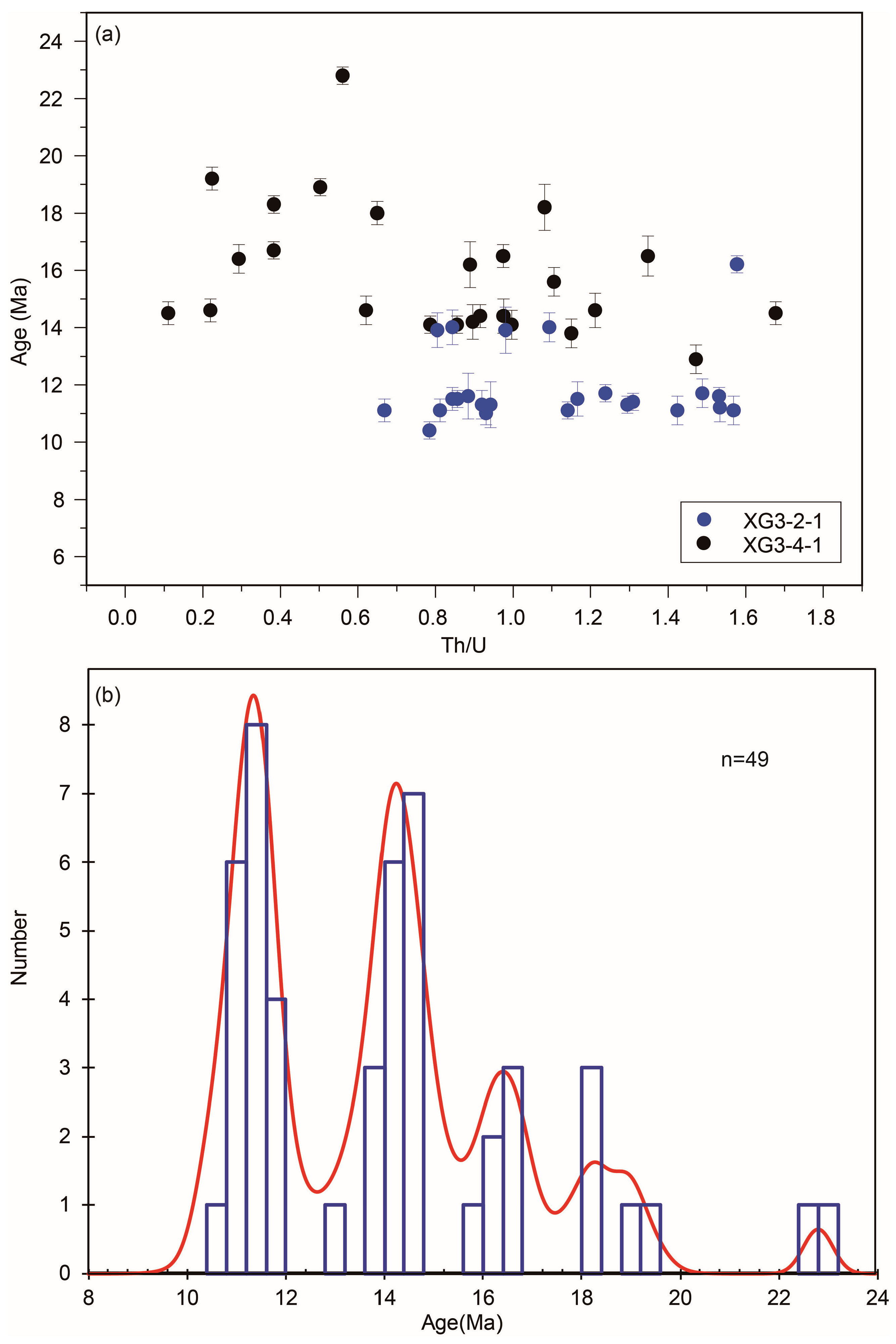
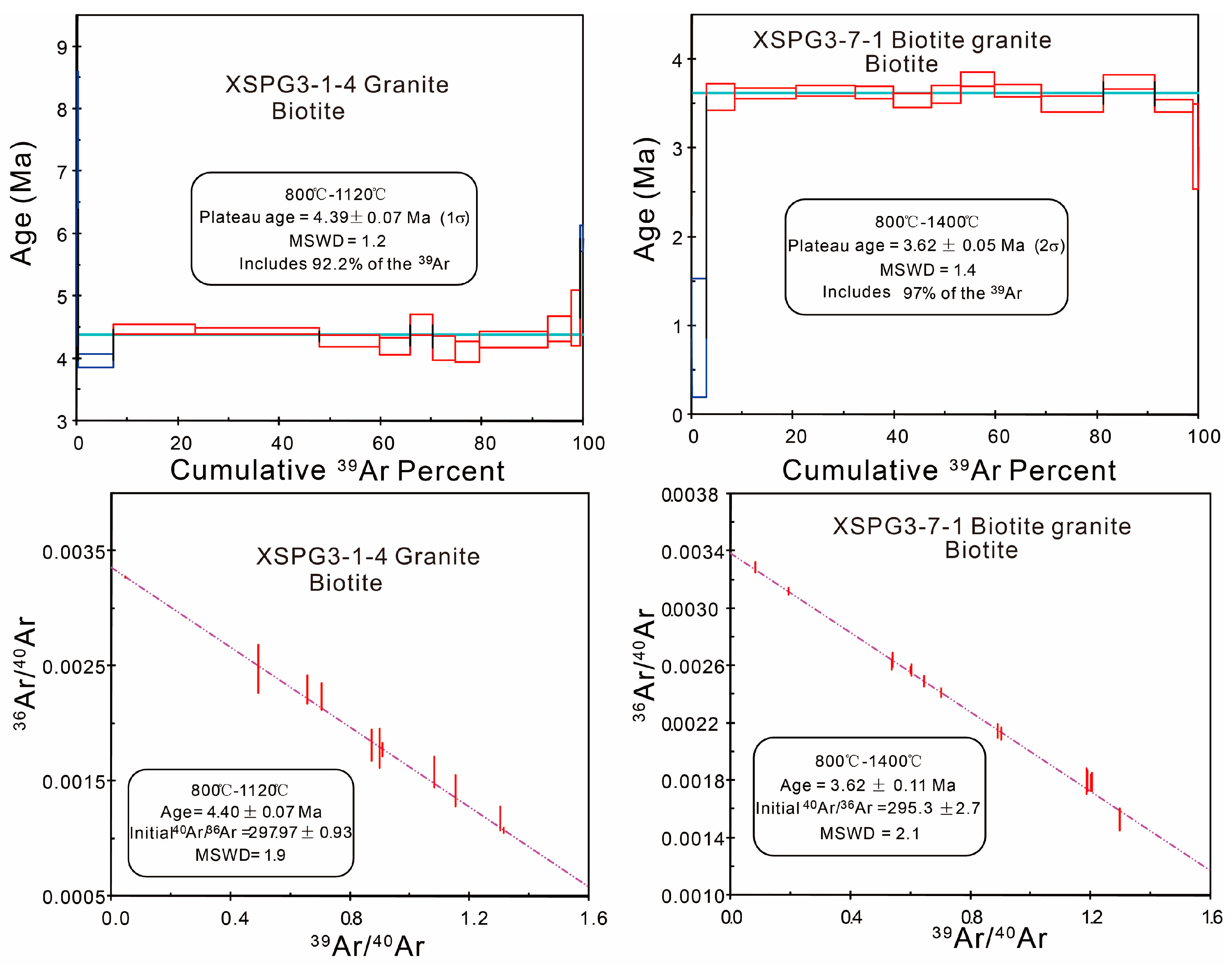
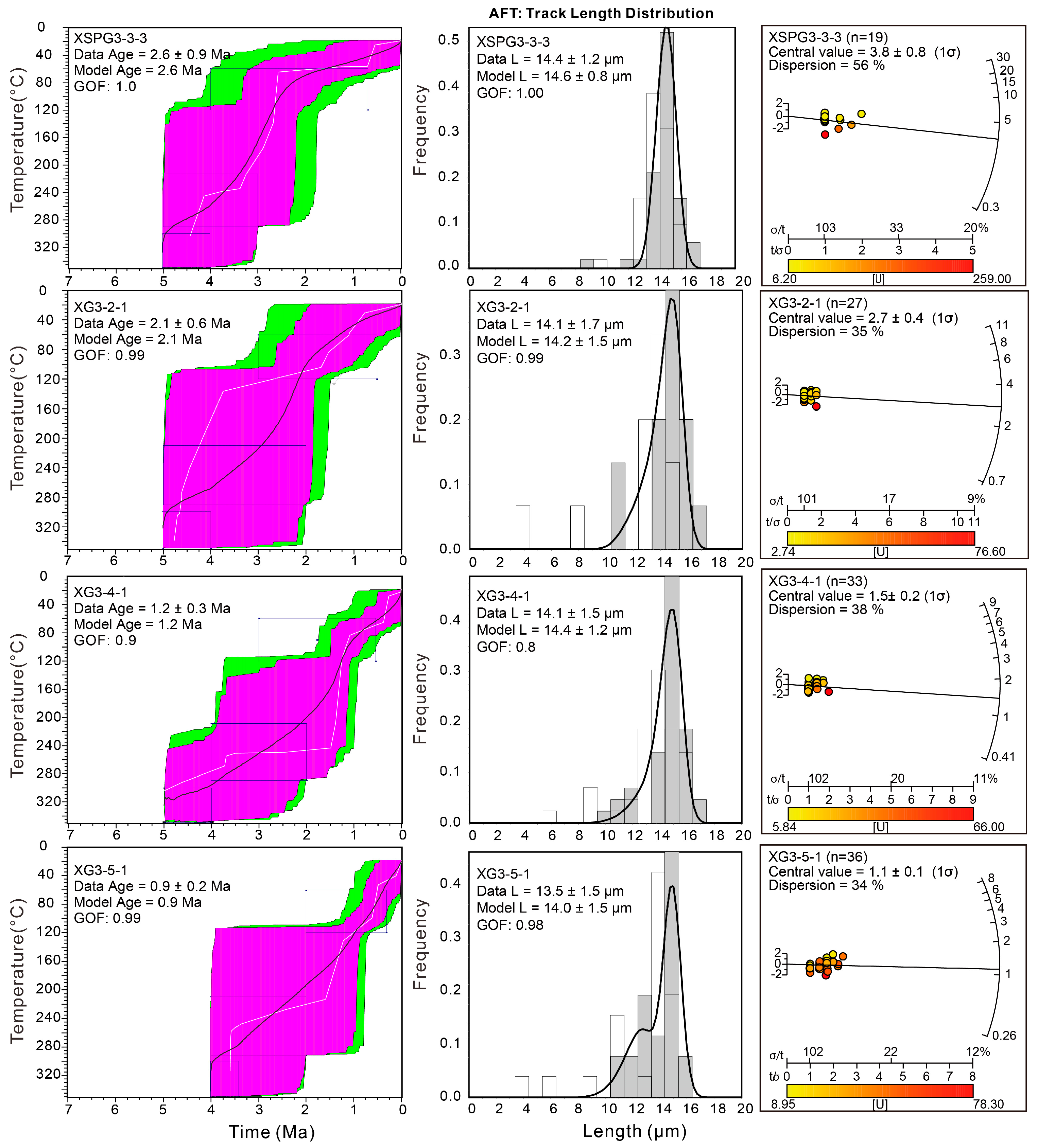

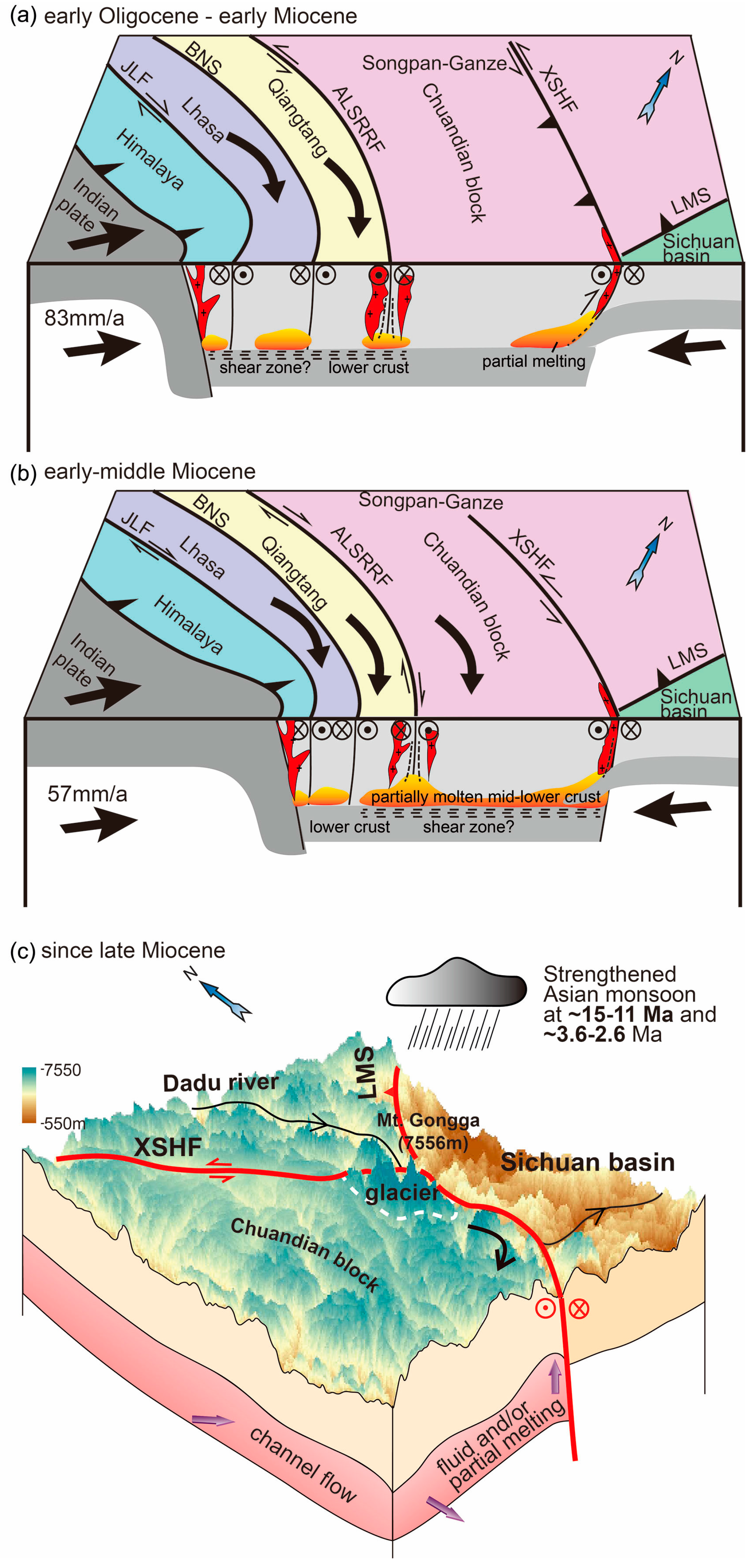
| Samples | Longtitude (°E) | Latitude (°N) | Elevation (m) | Rock Type | Age (Ma) ± 2σ | ||
|---|---|---|---|---|---|---|---|
| Zircon U–Pb | Biotite 40Ar–39Ar | AFT | |||||
| Pooled Age | |||||||
| XSPG3–3–3 | 101.7342 | 30.1844 | 4398 | granite | 2.6 ± 0.8 | ||
| XG3–2–1 | 101.7681 | 30.2375 | 3987 | granite | 11.3 ± 0.2 | 2.1 ± 0.4 | |
| XSPG3–1–4 | 101.7842 | 30.2558 | 3662 | granite | 4.39 ± 0.07 | ||
| XG3–4–1 | 101.8122 | 30.2644 | 3544 | granite | 14.3 ± 0.3 | 1.2 ± 0.2 | |
| XG3–5–1 | 101.8400 | 30.2817 | 3237 | granite | 0.9 ± 0.1 | ||
| XSPG3–7–1 | 101.8414 | 30.2786 | 3219 | granite | 3.62 ± 0.05 | ||
| Samples | Grains (N) | 1 Ns | 2 ρs (105 cm−2) | 238U (ppm) | 3 Dpar (µm) | P(χ2) [%] | Pooled Age (Ma ± 1σ) | 4 Nl | 5 MTL (µm ± se) | 6 SD (µm) |
|---|---|---|---|---|---|---|---|---|---|---|
| XSPG3–3–3 | 19 | 25 | 0.4683 | 40.6 | 1.4 | 40.7 | 2.6 ± 0.8 | 52 | 13.5 ± 0.2 | 1.33 |
| XG3–2–1 | 27 | 39 | 0.1857 | 15.6 | 1.3 | 43.3 | 2.1 ± 0.4 | 16 | 12.8 ± 0.8 | 3.2 |
| XG3–4–1 | 31 | 47 | 0.1397 | 20.5 | 1.3 | 39.1 | 1.2 ± 0.2 | 43 | 13.0 ± 0.3 | 2.1 |
| XG3–5–1 | 36 | 85 | 0.1777 | 34.8 | 1.3 | 71.9 | 0.9 ± 0.1 | 26 | 12.1 ± 0.6 | 2.82 |
Disclaimer/Publisher’s Note: The statements, opinions and data contained in all publications are solely those of the individual author(s) and contributor(s) and not of MDPI and/or the editor(s). MDPI and/or the editor(s) disclaim responsibility for any injury to people or property resulting from any ideas, methods, instructions or products referred to in the content. |
© 2024 by the authors. Licensee MDPI, Basel, Switzerland. This article is an open access article distributed under the terms and conditions of the Creative Commons Attribution (CC BY) license (https://creativecommons.org/licenses/by/4.0/).
Share and Cite
Wu, C.; Li, G.; Tian, Y.; Zhao, Z.; Dong, H. Tectonic–Climate Interactions Controlled the Episodic Magmatism and Exhumation of the Zheduo–Gongga Massif in the Eastern Tibetan Plateau. Minerals 2024, 14, 1108. https://doi.org/10.3390/min14111108
Wu C, Li G, Tian Y, Zhao Z, Dong H. Tectonic–Climate Interactions Controlled the Episodic Magmatism and Exhumation of the Zheduo–Gongga Massif in the Eastern Tibetan Plateau. Minerals. 2024; 14(11):1108. https://doi.org/10.3390/min14111108
Chicago/Turabian StyleWu, Chan, Guangwei Li, Yuntao Tian, Zhongbao Zhao, and Hanwen Dong. 2024. "Tectonic–Climate Interactions Controlled the Episodic Magmatism and Exhumation of the Zheduo–Gongga Massif in the Eastern Tibetan Plateau" Minerals 14, no. 11: 1108. https://doi.org/10.3390/min14111108
APA StyleWu, C., Li, G., Tian, Y., Zhao, Z., & Dong, H. (2024). Tectonic–Climate Interactions Controlled the Episodic Magmatism and Exhumation of the Zheduo–Gongga Massif in the Eastern Tibetan Plateau. Minerals, 14(11), 1108. https://doi.org/10.3390/min14111108






